| |
| The
Texas Theatre, also known locally as the crown jewel of downtown Palestine,
has been on a rise and fall rollercoaster since the year it opened, in 1917 as
“The Best Theatre.” For nearly a century the theatre has opened and closed
its doors for various tragic reasons, but today The Texas Theatre stands proudly
in downtown, and its magnificence has been restored through the help of locals
who share a love for theatre as well as the city of Palestine.
The Texas Theatre has since been returned to its original intended purpose of
live entertainment, and while the memories of tragedy are fading, they will not
be forgotten. |
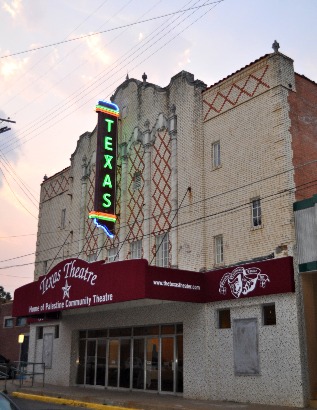 |
The Best Theatre
is believed by many to have been constructed for the purpose of Vaudeville performances,
before becoming a movie theatre in 1923, and eventually becoming part of a chain
of theatres. There is limited information regarding The Best Theatre, which once
stood where The Texas Theatre stands today.
Harold B. Robb and E.
H. Rowley built a theatre empire that spanned across three states. R. and
R. Corporation, also known as Robb and Rowley Theatres, were headquartered in
Dallas, Texas where they had opened
a chain of Texas Theatres. By the 1950’s Robb and Rowley owned and operated
over 150 theatres and drive-ins, in 34 towns in Texas,
Oklahoma, and Arkansas.
Robb
and Rowley hired renowned Texas architect W. Scott Dunne to design many
of their Texas Theatres. The men spared no expense as they built the most expensive
theatre in the Lone Star State, in the piney woods of East
Texas. The Texas Theatre in Palestine
is believed to have been the most expensive theatre built in Texas
at the time of its completion.
Theo S. Maffitt, an architect from Palestine,
was in charge of local plans for the theatre in the absence of Dunne during construction.
Two major contracts were also let to local businesses. Wm. Kraus and Sons was
awarded the general contract, and A.M. Burns was awarded the electrical contract.
Two Dallas contractors were awarded
contracts on the project as well.
According
to an article written in The Palestine Daily Herald on October 30, 1930, the finishing
touches were being added to the theatre in preparation for the gala opening the
following day. Contractors and their crews had been working “night and day” according
to the article, to ensure everything was in order for the grand opening of the
new $150,000 R. and R. Corporation (Robb and Rowley Theatres), the Texas Theatre.
Dunne
was in Palestine that day
overseeing the final details in connection with the completion of the theatre.
He announced that officials from R. and R. Corporation headquarters, along with
managers of over 20 Robb and Rowley Theatres, in different Texas
cities would be traveling to Palestine
for the grand opening of the greatest Texas Theatre. In all, Dunne said there
would be some 150 visitors arriving into Palestine.
“I don’t know of a theatre in
Texas in a town of as many as 75,000 people that is more modern than The Texas,”
Dunne told the Palestine Daily Herald of the city’s new jewel.
The article
went on to paint a picture of the magnificent Texas Theatre, located at 213 W.
Crawford Street in Palestine.
The Texas, styled in Italian design, opened to East
Texas as one of the most modern theatres in this part of the country, and
a seating capacity of approximately 1,200.
Those
arriving in East Texas the following
day were set for a pleasant surprise. Texas Theatre manager J. F. Jones and his
staff of assistants had worked tirelessly in preparation to accommodate theatre
patrons. Jones worked for Robb and Rowley Theatres for over 20 years, after a
brief career as an educator.
According to the article, the Texas Theatre
expected to receive guests from all over East
Texas for the gala opening. Nancy Carroll, one of the screen’s leading ladies,
was scheduled to appear in “Laughter” as the feature attraction on opening night.
News
paper articles and salvaged old photographs paint a clear picture of the theatre’s
grandeur when it originally opened. Patrons were welcomed into the large entrance
lobby, which is said to have been rich with blended colors. After passing through
the lobby entrance, patrons entered the grand foyer of the theatre, before entering
the main auditorium. Large bathrooms, along with smoking and lounging rooms were
also located on the main floor. Two terraced stairways in the foyer led to the
balcony of The Texas. The mezzanine floor was comprised of theatre offices, switchboard
rooms, and the projected balcony. |
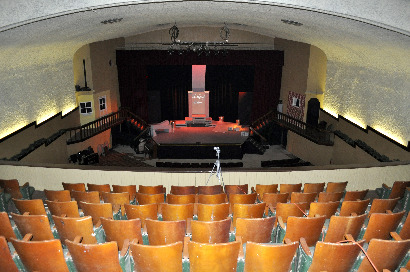 |
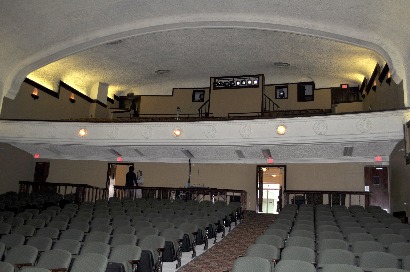 |
Dunne designed The
Texas auditorium as an Italian garden with balustrade walls and garden pagodas,
flanking a proscenium arch. The proscenium arch was adorned with lush, green velour
drapes, trimmed with silver fringe. A writer for the Palestine Daily Herald described
the drapes as “highly jeweled” in 1931.
The dome-shaped ceiling in The
Texas was originally of sky effect. Early day patrons of the theatre could look
up to see twinkling stars and clouds passing over The Texas’ dome. Today a sharp
eye can still spot the stars that once twinkled as the house lights were brought
down, according to the president of the theatre’s board of directors, Michael
Cook.
“The ceiling was originally blue and faded down into a deep rust
color to imitate a dusky sunset,” said Texas Theatre board member and Palestine
Community Theatre actress Amelia Cook.
The side walls of the auditorium
were enhanced with paintings of trees and flowers. Although patrons were inside
The Texas, they must have felt as if they were being entertained under the Texas
sky, where the stars at night are big and bright.
At the time of The Texas’
grand opening, the projection room was one of the largest in the state. The Texas
was equipped with the latest projection and sound technology. The theatre was
also designed with special acoustical plaster, which allowed for perfect reproduction
of sound.
The Texas also boasted of the latest in heating, venting, and
cooling equipment for patrons to enjoy as they took their places upon overstuffed
air cushions, covered with a velour finish.
“When someone wanted to impress
you they took you to the Texas Theatre in Palestine.
It was elaborate and luxurious,” said Amelia Cook.
Cook also explained
that The Texas Theatre was also air-conditioned, which was a rare commodity in
those days.
While
the chain of Texas Theatres all shared the same name and certain features, each
“Texas” sign was uniquely designed for each theatre. Texas Theatres signs pulsated
with neon and packed in crowds throughout the state. The Texas Theatre in Palestine
is the only Texas Theatre still operating with its original “Texas” sign. |
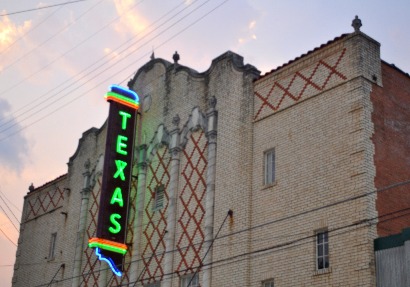 |
Less
than two months after the grand opening of The Texas, an early morning fire practically
destroyed Palestine’s new
theatre. According to the December 8, 1930 issue of the Palestine Daily
Herald, the theatre was destroyed to at least 75 percent of its entirety.
John
Hoye was employed as a janitor at The Texas at the time of the fire. Hoye told
a reporter from the local paper he had arrived at the theatre at approximately
4 a.m. in order to clean. Hoye said he turned the automatic gas heater on at approximately
5:45 a.m. and proceeded with his work. After mopping the lobby, Hoye returned
to the foyer where he discovered a fire under the east stairway, that was later
attributed to a problem with a heating plant.
At first the blaze was perceived
to be minor and was expected to be brought under control with ease. Hoye attempted
to put out the blaze with a supply of chemicals to no avail. Hoye then said he
went to the fire station to retrieve firemen and more chemical to distinguish
the blaze.
The slowly growing flames had already made their way upward
in the front of the building and made considerable headway by the time Hoye returned
with firemen. The firemen exhausted their supply of chemicals, but failed to extinguish
the flames. Water hoses from two nearby hydrants were also utilized in an effort
to snuff out the flames.
After two hours of fierce burning the flames
had ravaged the balcony and broken through the heavily tarred roof above the projection
room. Offices and the projection room were engulfed with flames. Thousands of
dollars in vitatone and movietone machinery were lost. Firemen were forced to
apply water in streams over the front of the building, allowing the water to drop
over on to the flames.
According to The Palestine Daily Herald, after
the flames broke through the roof, theatre manager J. F. Jones climbed upon the
front awning, and then crawled into the theatre through a window on the balcony
floor, where the safe was located. Jones opened the safe and collected a large
amount of money and important papers, and then grabbed a typewriter. Jones hauled
the rescued items to safety. As the flames roared inside The Texas and exploded
from the building, terrified onlookers screamed as Jones scampered down to safety.
Firemen
climbed to the top of the Denby Furniture Company building, then located on the
east side of the theatre, and streamed water on to the theatre. The fire was raging
out of control between the roof of the theatre and the magnificent starry sky
ceiling, and could not be reached by the water.
A few hundred local residents
stood on the street and witnessed The Texas go up in flames, and become nearly
a total loss.
Jones told The Palestine Daily Herald he did not know how
much insurance Robb and Rowley Theatres carried on the equipment, but believed
it to be largely covered. Jones also said he anticipated officials from the corporation’s
headquarters in Dallas to take action.
Roughly four months later, The Texas was resurrected. April 10, 1931,
just months after the Robb and Rowley Theatre had been ravaged by flames, the
doors were reopened to East Texans. Crowds swarmed The Texas Theatre for the opening
“Parlor, Bedroom and Bath,” featuring Buster Keaton.
The Palestine Daily
Herald recorded the second opening of The Texas and noted impressed patrons who
had arrived early to marvel the beauty of the recently rebuilt structure.
Sadly,
The Texas caught fire again, nearly a decade later. June 8, 1940, problems
with the air conditioning unit gave way to fire. Luckily, the fire of 1940 was
nowhere near the magnitude of the fire that had left the theatre in ruins ten
years earlier. |
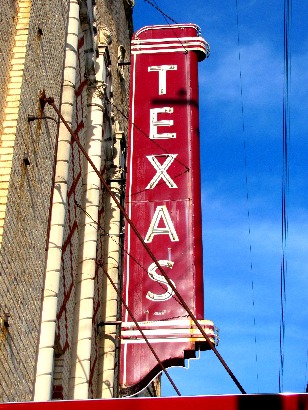 |
Over
time, Robb and Rowley relinquished ownership of The Texas Theatre in Palestine,
and a family by the name of Schulman took over. The Schulmans managed The
Texas as a movie theatre until the 1970s, at which point they opened at another
location. According to locals, all of the seats in The Texas were removed so the
facility could not be used as a theatre in the future.
In 1983, a small
group of local residents joined forces and finances to salvage the theatre. Five
partners, known as the Texas Joint Venture, purchased the theatre which had been
empty for quite some time. A few years later, the Palestine Community Theatre
purchased the property from Texas Joint Venture in 1991. According to the Cooks,
plays had never been performed in The Texas until this transaction. Community
plays were produced in the theatre until 1997, when the group was forced to shut
the doors of The Texas again, due to unsafe conditions.
According to Cook,
The Texas Theatre has not only suffered fire damage over the years, but flood
damage as well. Cook recalled one instance in which the theatre was severely flooded.
She said those who were attempting to make repairs and salvage items were forced
to wade through knee-deep water in the auditorium.
Thus
began a lengthy rebuilding process for The Texas Theatre. Members of the Palestine
Community Theatre pulled together and poured their hearts and souls into refurbishing
The Texas Theatre. The process was as discouraging as it was long for theatre
members.
Contributions from generous local residents trickled in slowly,
and the group hosted cleanup days in an effort to involve the community. On one
particular occasion, no one showed for cleanup day. The Cook family continued
to clean but were ultimately discouraged. While the Cooks cleaned the Mayor George
Foss made an unexpected visit to the theatre to take a look at the progress being
made. Foss recommended the theatre use a program that implemented the assistance
of prisoners from the Texas Department of Criminal Justice (TDCJ).
According
to the Cooks, the theatre was on a tight budget, with approximately $20,000 to
spend and TDCJ was searching for a project that would showcase their work capabilities.
The Cooks were asked to compile a “wish list” regarding their vision for the theatre
and just days later the warden was visiting the theatre to view TDCJ’s future
project.
The Palestine Community Theatre bought all of the supplies to
repair and refurbish the theatre, and agreed to feed the inmates two meals a day,
Monday through Thursday, until the project was complete.
“We made fresh
coffee and brought fresh fruit and a variety of donuts for breakfast. People from
the community helped feed the inmates home cooked buffet-style meals, and helped
supply drinks. There were about 20 inmates, but we prepared enough to feed about
50 or 60,” said Cook.
The Dogwood festival and opening night were a week
away when the city informed the Cooks the inmates were needed for cleanup, in
preparation for festivities. The Cooks knew that without the help of the inmates
the theatre would not be ready for opening night.
“Two inmates went to
the guard, who was a retired contractor and told him which workers were the most
skilled and could finish the theatre,” said Cook, moved by the inmates gesture
and desire to see the theatre finished.
The group of inmates were split
into two groups. One group cleaned around the city and the other stayed at the
theatre to ensure that everything would be ready for opening night.
“They
were literally running everywhere in the theatre trying to hurry,” said Cook. |
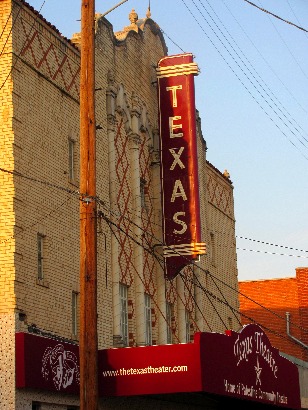 |
Texas
Theatre - marquee & neon sign
Photo
by Dana Goolsby, 2011 |
View
of auditorium from the third floor
Photo
by Dana Goolsby, 2011 |
Nearly
eight years after closing its doors the Texas Theatre reopened to the public during
the Dogwood Festival of 2005. The community had restored the once majestic
theatre to a new state of grandeur and given it a new purpose- live theatre.
Robb
and Rowley Theatres have been making headlines for almost a century. On November
22, 1963, Dallas police officers descended on the Texas Theatre in Oak Cliff
in search of a man who had entered without paying. That man was the lone assassin
of President John F. Kennedy – Lee Harvey Oswald.
In recent news, The
Pines theatre in Lufkin, also
a Robb and Rowley theatre, made headlines during the restoration of the theatre.
During the interior demolition phase crews made interesting architectural discoveries.
A hidden staircase was discovered, as well as the original brick arch ways which
were hidden behind asbestos and plaster. The city of Lufkin
continues to work toward restoring the Pines
Theatre.
Many of the Texas Theatres met their demise in flames, others
embraced wrecking balls, and others fell into shambles but were spared by communities
looking to hang on to history. After nearly a century of tragedy and neglect,
and a host of closings and re-openings, the Texas Theatre in Palestine
has been salvaged and reborn.
The Texas Theatre in Palestine
is a non-profit organization. For more information regarding upcoming shows at
the Texas Theatre in Palestine
log on to www.thetexastheater.com.
Dana Goolsby
can be reached for comment via email at dana.n.goolsby@gmail.com
©
Dana Goolsby
"In
The Pines With Dana Goolsby"
June 4, 2011 Column
More Theatres
in Texas
Related
Topics:
Palestine,
Texas | Tales from Texas' Past | East
Texas | Texas | |
| Save on Hotels
- Expedia
Affiliate Network | |